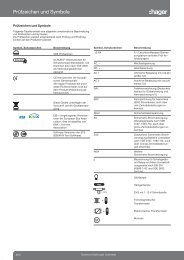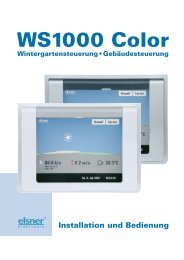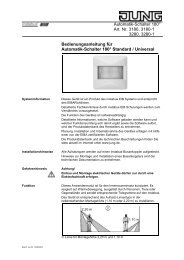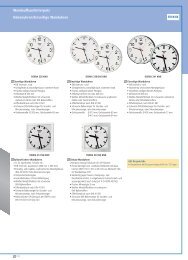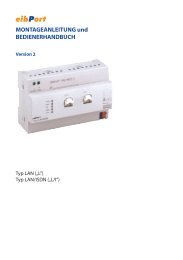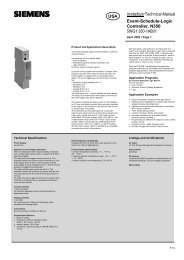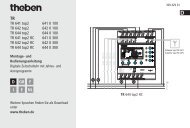Create successful ePaper yourself
Turn your PDF publications into a flip-book with our unique Google optimized e-Paper software.
4.2.4.12 Signalling system<br />
4.2.4.12.1 Introduction and basic principles<br />
Introduction<br />
The signalling system allows the inclusion of existing sensors of a KNX/EIB installation in the<br />
project planning of the panel to monitor a building or part of a building. The signalling system<br />
can display the status of window contacts, motion detectors or glass break sensors and monitors<br />
changes in the statuses of these detectors.<br />
The detectors integrated in the signalling system can be combined into up to two security areas.<br />
Arming these areas allows monitoring of the secured area for break-ins when people are<br />
present in or absent from the building. In addition, sections of the area can be monitored for<br />
sabotage. If there is a break-in alarm, visual and acoustic alarms can be activated.<br />
The signalling system can be checked directly on the panel using a separate system page (see<br />
picture 35). The system status (active detectors, events) and operation (arming/unarming, acknowledgement)<br />
is made simple and clear by predefined screen icons and pages. In addition,<br />
arming or unarming is possible using other bus subscribers - for example touch sensors or button<br />
interfaces and binary inputs with connected operating units. In addition, in the case of an<br />
alarm or fault, it is also possible to display system statuses or detector texts on other KNX/EIB<br />
display units - e.g. info displays or simple LED displays. The signalling system makes separate<br />
communication objects available for this.<br />
It should be noted that a reset to readiness after an alarm or a fault, or the viewing of the event<br />
memory is only possible on the panel as a central component.<br />
Order-No. 7574 00 1X<br />
picture 35: System page of the signalling system<br />
Software "...590101"<br />
Functional description<br />
i As a function component of the panel, the signalling system is not a complete alarm system.<br />
For example, if the main or bus power supply fails, uninterrupted operation is not guaranteed.<br />
In addition, no signal encoders or transmission devices can be directly connected<br />
to the system, meaning that there is no opportunity to monitor these elements. The panel's<br />
signalling system is also not VDS-certified.<br />
If such functions or characteristics are required, the a suitable KNX/EIB alarm centre must<br />
serve as a replacement.<br />
Security areas and configuration<br />
A security area is an area of the signalling system, which secure specific parts of a building<br />
such as individual rooms, building wings or facade areas and monitors them for break-ins. In the<br />
security areas, detectors are those components which allow such monitoring. These detectors<br />
could be magnetic contacts on windows or doors, motion detectors on walls or ceilings in interiors<br />
as well as glass break sensors. Detectors can be connected to the KNX/EIB via suitable<br />
components (button interfaces, binary inputs, etc.) or, depending on the device version, be connected<br />
to the KNX/EIB directly.<br />
Security areas can be activated and deactivated, i.e. armed and unarmed. Arming and unarming<br />
takes places either directly on the panel or using the external KNX/EIB switching units.<br />
Page 110 of 222






